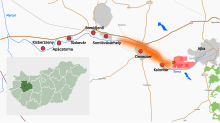Ajka alumina plant accident
| Ajka alumina plant accident | |
|---|---|

Spill site and affected localities
|
|
| Location | Ajka, Hungary |
| Coordinates | 47°05′09″N 17°29′40″E / 47.085705°N 17.494326°ECoordinates: 47°05′09″N 17°29′40″E / 47.085705°N 17.494326°E |
| Date | 4 October 2010 |
| Cause | Under investigation |
| Casualties | 10 deaths, 150 injured |
| Operator | MAL Hungarian Aluminium |
| Volume |
ca. 1 million m3 (35 million cu. ft.) |
| Area | 40 km2 (15 sq mi) |
The Ajka alumina sludge spill was an industrial accident at a caustic waste reservoir chain of the Ajkai Timföldgyár alumina plant in Ajka, Veszprém County, in western Hungary. On 4 October 2010, at 12:25 CEST (10:25 UTC), the northwestern corner of the dam of reservoir no. 10 collapsed, freeing approximately one million cubic metres (35 million cubic feet) of liquid waste from red mud lakes. The mud was released as a 1–2 m (3–7 ft) wave, flooding several nearby localities, including the village of Kolontár and the town of Devecser. Ten people died, and 150 people were injured. About 40 square kilometres (15 sq mi) of land were initially affected. The spill reached the Danube on 7 October 2010.
It was not initially clear how the containment at the reservoir had been breached, although the accident came after a particularly wet summer in Hungary, as in other parts of central Europe. Police have seized documents from the Ajkai Timföldgyár plant, although a spokesman for MAL Hungarian Aluminium (MAL Magyar Alumínium Termelő és Kereskedelmi Zrt.), the company that operates the plant, said the last inspection of the pond had shown "nothing untoward". Hungarian Prime Minister Viktor Orbán stated that the cause of the spill was presumably human error.
The red mud involved in the accident is a waste product of the Bayer process, which refines bauxite into a form of aluminium oxide called alumina. The mud primarily contains non-aluminium compounds present in the bauxite ore and left as residues after its refining along with sodium hydroxide used to dissolve aluminium oxide. Iron(III) oxide, the compound from which the red color originates, is the main component, but it also contains other compounds. The mud, which is highly alkaline when it is first produced, is stored in large open-air ponds; It is thought that there is about 30 million tonnes of red mud stored around the Ajkai Timföldgyár plant. According to a press release by MAL, the mud had the following chemical percentage make-up (which expresses the amounts of different elements, not necessarily the actual solids).
...
Wikipedia
